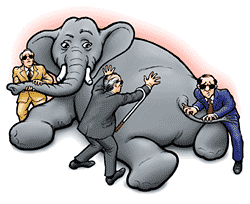 The best way to keep one's profession going in Nepal in these times of economic decline, it seems, is to create panic and talk down on everything. Whether it is predicting that the conflict will rage on for another decade, or there will be an earthquake soon, the rupee is headed for devaluation, or the sky will fall.
The best way to keep one's profession going in Nepal in these times of economic decline, it seems, is to create panic and talk down on everything. Whether it is predicting that the conflict will rage on for another decade, or there will be an earthquake soon, the rupee is headed for devaluation, or the sky will fall. In Nepal, Chicken Little is alive and kicking ass. Economists have started predicting the fall of the Nepali Rupee vis-?-vis the Indian Rupee thereby bringing inflationary trends in the Nepali economy. Economists should behave as economists, not doomsday soothsayers. And the Nepali Times should stop quoting them (See: 'Coming soon', #231).
This Beed has actually being arguing the opposite. In a column three years ago in this space ('Free the Nepali rupee', #59) I had challenged why the exchange rate should just be 1.3 and not 1.6. Since no donor money was thrown in for this study, it did not get any responses.
Economic analysts in Nepal are either academics who have outgrown their utility or consultants who are tired of writing 'cut and paste' reports. Unfortunately, no corporate house or the plethora of business associations has economists who analyse issues as critical as the exchange rate. We have associations of junket-savvy economists who are happier to play ceremonial roles at workshops and provide sound bytes to television.
The exchange rate between India and Nepal is driven by pure politics and not economics. How else can one explain no revision of the exchange rate since 1 February 1993? In the past 11 years, the compositions of imports and exports have changed and this should definitely have affected the currency. Third country exports of carpets, garments and pashmina boomed and busted, the exchange rate did not budge.
Gold imports, a major currency ticket item, declined but it made no impact. Hard currency remittances have increased multifold thereby increasing the foreign exchange reserves of the country. This should have revalued the Nepali currency upwards not downwards. The argument that the Nepali rupee is over-valued against the dollar as this paper reported does not carry much weight. One has to interview real economists, not gossip-mongers.
While it is good to have a fixed currency rate that does not change over a long period of time, a system of periodic review of exchange rate becomes important. With the Euro emerging as a stronger currency and the dollar losing ground, the Chinese yuan gaining importance with a stronger economy, the Indian rupee riding on strong ambitions, the fixed exchange regime with India and the modality on fixing the parity needs constant analysis.
The parity between India and Nepal exchange rate was established in 1960 to stem fluctuations of market prices in Nepal as the basket of the poor comprised mostly of items imported from India. We really need to revisit the rationale and establish timely justifications on the parity and surely give 1.6 a second look.
So, once again: 1.3, 1.4, 1.5. Rather than play Russian roulette we should engage in meaningful research. Definitely an upward revaluation means greater purchasing power, a stronger currency and surely higher
GDP.



